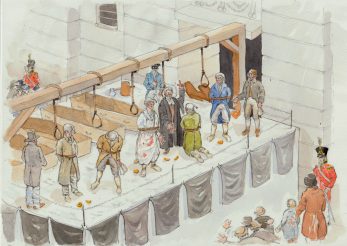Cato Street Conspirator: William Davidson



- This article is based on a review of Ryan Hanley’s essay “Cato Street and the Caribbean” featured in the Manchester University Press book, “The Cato Street Conspiracy”, which features numerous essays on the conspiracy and conspirators. The article will detail William Davidson’s early life then into his time with the Thistlewood group and his impending execution following the arrests on Cato Street.
Born in Jamaica in 1786, William Davidson was born to his high-status Jamaican mother, and who his father was is unknown. Historians believe Robert Sewell is most likely to be Davidson’s father since he was in post when William was born. Old accounts claim his father to be Attorney-General Davidson but more recent research explains that during the years William was born and growing up, there was no Attorney General with the name Davidson, so many believe William took his mother’s name when he was born. With the knowledge of his father unable to be confirmed, we know he was born a free man because his mother was highly respectable and was able to help William financially throughout his life. Even though he was not born into slavery, Davidson grew up in the Caribbean where he witnessed the effects that slavery had on their communities and this eventually led him to participate in political activism.
When Davidson was young, in his early teens, he was sent to Edinburgh by his father to study law, but then moved to Aberdeen to study mathematics at college. After a successful college career, he went on to work for his father’s friend in Liverpool before enlisting on board a merchant ship. Though this is all alleged and there is no way to tell what happened during his young years, we do know that he was press-ganged into joining the Royal Navy. He moved to London in 1816 when he was discharged and this was when he became involved in radical politics. Davidson joined the Thistlewood group and preached about the need for arm resistance and ‘death-or-glory’ commitment to the group’s cause. George Edwards, a spy that testified against Davidson, claims that he saw Davidson with a banner that read “Let us die like men and not be sold like slaves” and another testified against him said that Davidson had been seen asking around for old files to be sharpened into pike-heads, which were mostly used by rebels.
Being a tall, built man gave Davidson that fear factor that is thought to be the reason for the conspirators to be let into the hayloft on Cato Street by the guard, along with his experience in the military. He was known in his neighbourhood as intimidating and was often seen walking around late at night with something that was thought of to be either a gun or a great stick under his coat. Even though Davidson had an intimidating stature, the colour of his skin made him memorable for witnesses and even the other conspirators. Because Davidson was Black, he was one of the more recognizable among the conspirators, and why he wasn’t able to get the charges against him dropped, while a small number of the white conspirators were able to.
Once arrested, Davidson was aware of the racial prejudice he was subject to during his trial, but he was determined to use that to his advantage. Davidson’s defensive method was to present himself as a member of the educated elite and detached from the people of colour in Britain. He claimed to have found men of colour ignorant and he did not associate with them. At the same time, he was making these claims, he was also stating that he was a victim of racial profiling and had been targeted by those in his community. His main defence was that he had been mistaken for another Black man and was not guilty of the crimes being charged, this method of defence did not prove to be convincing enough for the jury to believe.
Despite his best efforts, Davidson was convicted, publicly hanged, and decapitated alongside four other conspirators on May 1st, 1820. After Davidson’s execution, he was depicted as a rough, violent man who neglected his children and his wife, and other writings use many racial stereotypes to describe him. While he was most likely a violent man, as he was involved in the Thistlewood group and was convicted for treason, it’s likely that biographers used anti-Black language and racism to advance the public’s hatred against Davidson. Even with being born to high status, being a free man of colour, having higher education, and having family connections, Davidson was still faced with many hardships and social challenges because he was Black throughout his entire life. Blackness in Britain during this time was linked with fewer professional and social opportunities which forced lots of Black people into poverty and not being able to provide for their families.





Comments about this page
Nice article Kate!
Add a comment about this page